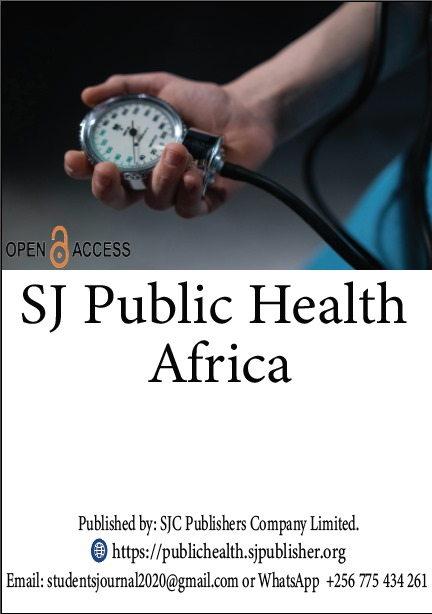Individual factors affecting waste disposal by community members of Ihunga sub-county, Ntungamo district. A cross-sectional study.
DOI:
https://doi.org/10.51168/y8fkpj65Keywords:
Individual factors, Waste disposal community members, Ihunga sub-county, Ntungamo districtAbstract
Background
Financial rewards and awareness related to the recycling benefits, and available community support were found to be critical drivers of Solid Waste Segregation and Recycling. The study aims to determine the individual factors affecting waste disposal by community members of the Ihunga sub-county, Ntungamo district.
Methodology
A descriptive cross-sectional study design was used and it will utilize the quantitative method of data collection. The sample size consisted of 40 respondents who were selected from the community members of the Ihunga Sub-county in Ntungamo District using a random sampling method.
Results
The female percentage of 57.5% of respondents was higher. Most respondents were between the ages of 31-35 years. All (100%) of the respondents did not have waste bins in their homes. 60% of the respondents had rubbish pits where they collect waste that decays and when the rubbish pits are full, they empty them to the plantations and work as manure. 40% of the respondents threw waste anywhere. 8, 80% of female respondents were willing to pay for improved waste disposal.7 0% of the respondents reported that urbanization has increased waste in the community, while, 30% of the respondents reported that they didn’t agree with the waste disposal policies.
Conclusions
The most significant factors affecting waste disposal by community members were knowledge about proper waste disposal management, urbanization, and failure to pay for improved waste disposal services.
Recommendations
Community members should now think of paying for waste disposal services, especially for plastics that do not decay to avoid pollution to the environment and water bodies Households should get containers where to collect the plastics and take them for recycling.
References
Addai, K.N., & Danso-Abbeam, G. (2014). Determinants of Willingness to Pay for Improved Solid Waste Management in Dunkwa-on-Offin, Ghana.
Chao Li, Xiangzhou Yuan, Ziying Sun, Manu Suvarna, Xun Hu, Xiaonan Wang, Yong Sik Ok,
Dadson Awunyo-Vitor, Shaibu Ishak, Godfred Seidu Jasaw, "Urban Households' Willingness to Pay for Improved Solid Waste Disposal Services in Kumasi Metropolis, Ghana", Urban Studies Research, vol. 2013, Article ID 659425, 8 pages, 2013. https://doi.org/10.1155/2013/659425
Drake H, Ivarsson M, Tillberg M, Whitehouse MJ, Kooijman E. Ancient Microbial Activity in Deep Hydraulically Conductive Fracture Zones within the Forsmark Target Area for Geological Nuclear Waste Disposal, Sweden. Geosciences. 2018; 8(6):211. https://doi.org/10.3390/geosciences8060211
Fadhullah, W., Imran, N.I.N., Ismail, S.N.S., et al. Household solid waste management practices and perceptions among residents in the East Coast of Malaysia. BMC Public Health 22, 1 (2022). https://doi.org/10.1186/s12889-021-12274-7
Hanafi A. Punch Newspapers; 2018. Plastic Pollution: Nigeria‘s Untapped ‗waste Wealth‘ Fuels Environmental Disaster; pp. 18–19.https://punchng.com/plastic-pollution-nigeriasuntapped-waste-wealth-fuels-environmental-disaster/
Mugambe, R. K., Nuwematsiko, R., Ssekamatte, T., Nkurunziza, A. G., Wagaba, B., Isunju, J. B., Wafula, S. T., Nabaasa, H., Katongole, C. B., Atuyambe, L. M., & Buregyeya, E. (2022). Drivers of Solid Waste Segregation and Recycling in Kampala Slums, Uganda: A Qualitative Exploration Using the Behavior Centered Design Model. International journal of environmental research and public health, 19(17), 10947. https://doi.org/10.3390/ijerph191710947
Shewasinad, S. Et al. (2017) ‘Assessment of Knowledge Attitude and Practice towards Solid and Liquid Waste Management among Addis and Kometa Kebele Community Mizan-Aman Town, Bench – Maji’, 1(5), pp. 1346–1354. https://doi: 10.26717/BJSTR.2017.01.000434.
Downloads
Published
Issue
Section
License
Copyright (c) 2025 FELEX MUHUMUZA, DONATUS KIMERA (Author)

This work is licensed under a Creative Commons Attribution-NonCommercial-NoDerivatives 4.0 International License.
The journal publishes under the Attribution-Noncommercial-NoDerivatives 4.0 international (CCBY-NC-ND 4.0) license which allows you to Share, Copy and redistribute the materials in any medium or format. The licensor cannot revoke these freedoms as long as you follow the license terms;
- Attribution: You must give appropriate credit, provide a link to the license, and indicate if changes were made. You may do so in any reasonable manner, but not in any way that suggests the licensor endorses you or your use.
- Non-commercial: You may not use the material for commercial purposes. Commercial use is one primarily intended for commercial advantage or monetary compensation.
- No Derivatives: if you remix, transform, or build upon the material, you may not distribute the modified material.
- No additional restrictions: You may not apply legal terms or technological measures that legally restrict others from doing anything the license permits.




